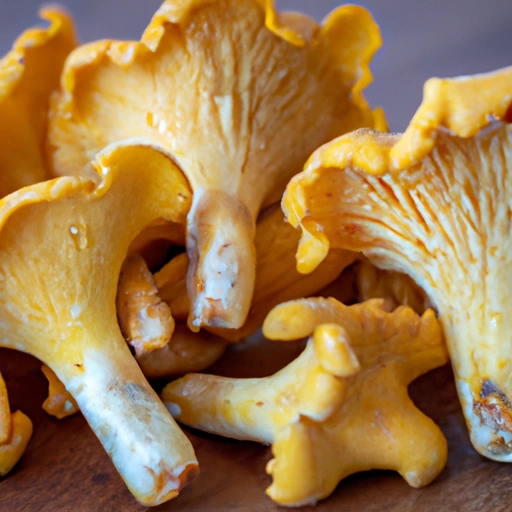Chanterelle
Description

The chanterelle mushroom is a prized ingredient in culinary circles, renowned for its delicate flavor and meaty texture. Known by its scientific name Cantharellus cibarius, it is easily recognizable by its vibrant yellow to orange color and its funnel-shaped, wavy cap. Chanterelles are found in various parts of the world and add a gourmet touch to numerous dishes. They are as versatile as they are flavorful and can be used in anything from simple sautés to elaborate sauces.
Common uses
Chanterelles are commonly used in gourmet kitchens worldwide and are featured in a variety of culinary applications. They can be used fresh, dried, or preserved and are often found in markets during their growing season, which typically lasts from summer through fall.
Nutritional value
Calories
Chanterelles are low in calories, with approximately 38 calories per 100 grams (3.5 ounces).
Protein
They provide a moderate amount of protein, offering about 1.5 grams per 100 grams (3.5 ounces).
Fat
These mushrooms are low in fat, containing less than 1 gram of fat per 100 grams (3.5 ounces).
Carbohydrates
Chanterelles contain around 7 grams of carbohydrates per 100 grams (3.5 ounces).
Vitamins
They are a good source of Vitamin D, Vitamin C, and certain B vitamins.
Minerals
Chanterelles are rich in minerals such as potassium, copper, and selenium.
Health benefits
The nutritional profile of chanterelles suggests several health benefits. They support bone health due to their vitamin D content, boost the immune system with vitamin C, and the B vitamins present can aid in metabolism and energy production. Minerals like selenium act as antioxidants, while potassium helps to maintain cardiovascular health.
Potential risks
While chanterelles are generally safe to eat, they should be properly identified as there are poisonous look-alikes, such as the false chanterelle. It is also important to consume them in moderation, as some individuals may experience allergic reactions or gastrointestinal discomfort. As with all wild mushrooms, they should be thoroughly cleaned and cooked before consumption.
Common recipes
Chanterelle mushrooms can enhance the flavor of various dishes such as soups, stews, risottos, omelets, and sauces. They are particularly popular in French and Scandinavian cuisine.
Cooking methods
The mushrooms can be sautéed, roasted, grilled, or stewed. Cooking chanterelles releases their woodsy flavor and aroma, making them a delightful addition to any dish.
Pairing with other ingredients
Chanterelles pair well with ingredients like garlic, thyme, parsley, cream, butter, white wine, and mild cheeses. They complement both meat and vegetable dishes.
Summary
In summary, chanterelles are a beloved mushroom variety with a rich history and numerous culinary applications. They offer a range of health benefits while being low in calories and fat. Whether foraged in the wild or purchased from a market, chanterelles can elevate the flavors of your recipes and bring a touch of gourmet into your home cooking.